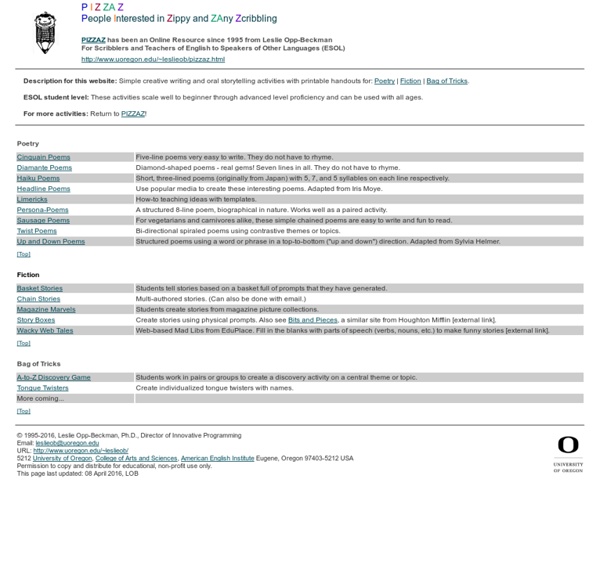



http://darkwing.uoregon.edu/~leslieob/pizzaz.html
Related: writing • ammmi45 ways to avoid using the word 'very' Writers Write is your one-stop resource for writers. Use these 45 ways to avoid using the word ‘very’ to improve your writing. Good writers avoid peppering their writing with qualifiers like ‘very’ and ‘really’. They are known as padding or filler words and generally add little to your writing.
Teaching Your Students How to Have a Conversation I was recently in a third grade classroom and was struck by the presence of rules that were posted for how to have a conversation. The poster said, "Each person must contribute to the discussion but take turns talking. Ask each other, 'Would you like to add to my idea?' or 'Can you tell us what you are thinking?' Dr. Seuss Theme - Lesson Plans, Thematic Units, Printables, Worksheets Celebrate Dr. Seuss’s Birthday: March 2, 1904 Lessons, Printables & Resources @ A to Z Dr. Seuss Activities Cross-curricular activities for 15 Dr. Seuss books, including The Foot Book, Dr. Writing Topics Jump to navigation All online writing units are free ($0) during the pandemic. Thank you for teaching! Writing Topics How do I use writing topics in my classroom?
ESL Worksheets These printable ESL worksheets provide quick overviews of grammar concepts including present, past and future tenses, conditional forms and more. Each ESL worksheet reviews essential grammar and provides printable quizzes and answer sheets to help students quiz and test concepts introduced. These ESL worksheets can be printed as additional study resources or for in-class lesson plans.
101 Persuasive Essay and Speech Topics 101 Persuasive Essay Topics By: Mr. Morton Whether you are a student in need of a persuasive essay topic, or a teacher looking to assign a persuasive essay, this list of 101 persuasive essay topics is a great resource. I taxed my brain to create this huge list of persuasive essay topics relevant to today’s society, but I believe it was worth the effort.
The Teacher’s Guide to Using YouTube in the Classroom YouTube is one of the most popular websites on the planet and a vast resource for educational content. The site is home to over 10 million videos tagged as educational, many of them submitted by your fellow teachers. A completely free resource this huge and varied has nearly endless potential for the classroom. Here are some ideas and suggestions to get you started. Ways to Use YouTube in the Classroom
English Tenses for Beginners - Past Present and Future Tense Forms Guide to past, present and future verb tenses especially for beginners. These tense resources include explanations and examples for each tense in English, as well as tense worksheets and quizzes which can also be printed for in-class use. Guide to Future with Will and Going toGuide to learning Future with Will and Going to for students and teachers.